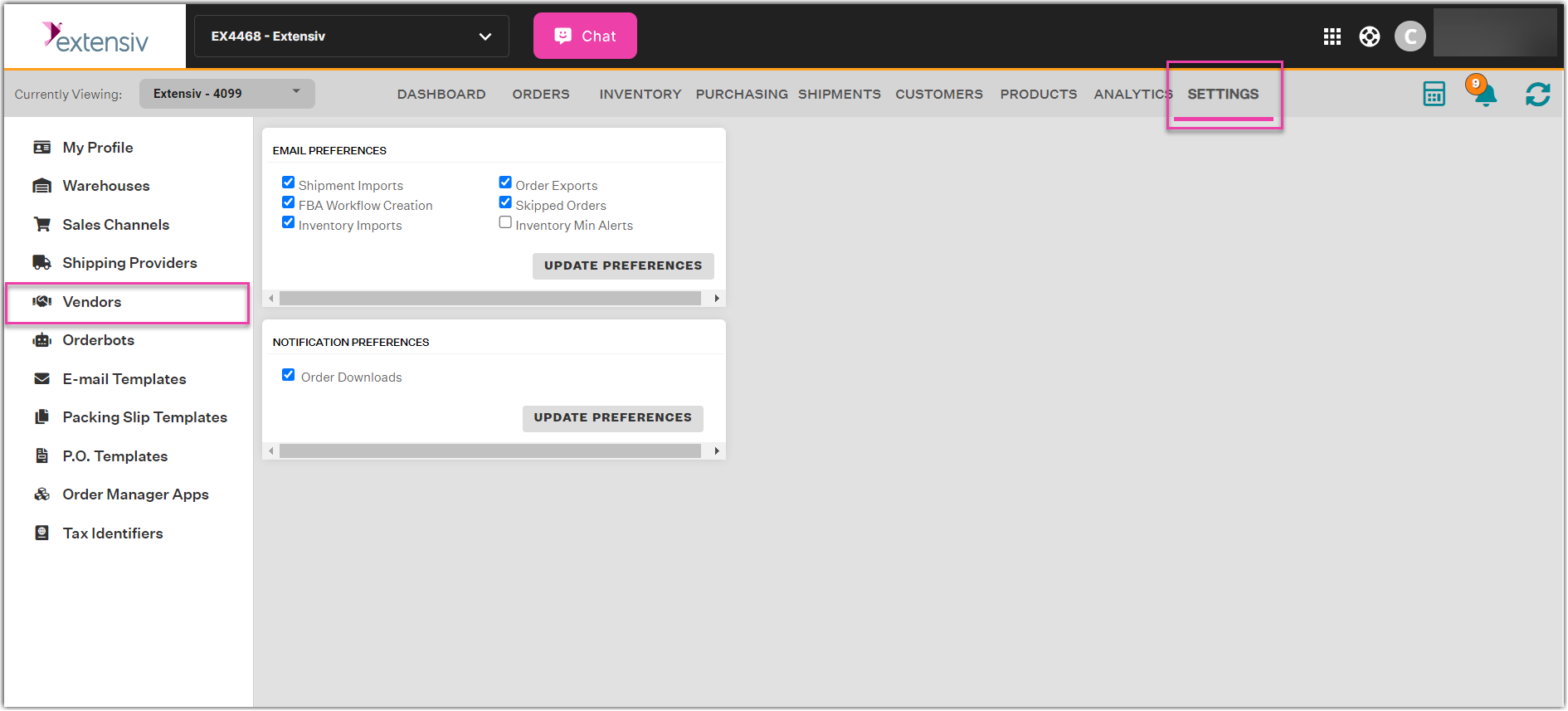-
Settings
-
General
- Configuring Shipping Presets
- Update My Profile
- Disable the Inventory Update From Extensiv Order Manager to All Sales Channels
- How to Enable Out of Stock Control for eBay Sales Channels
- Company Info and Additional Account Settings
- Installing an App from the Order Manager App Store
- How to View Your Extensiv Order Manager Invoices
- How To Remove an App in Order Manager
- Ruby Has 3PL Integration
- Company Time Zone Setting
- Tax Identifiers
-
Sales Channels
- Deactivating a Sales Channel
- Editing Sales Channels
- Enable or Disable Extensiv Order Manager Email Notifications to Your Customers
- Shopify Tags
- Shopify Locations
- Amazon Cancellation Settings
- Steps in Adding Walmart as a Sales Channel
- Adding Newegg as a Sales Channel
- Adding eBay as a Sales Channel
- Viewing a Sales Edit Channel's History
- Reactivating Sales Channels
- Adding Amazon as a Sales Channel
- Adding Shopify as a Sales Channel
- Adding a Manual Sales Channel
- Adding Sales Channels
- Assigning a Packing Slip and/or Email Template to your Sales Channel
- How to Exclude a Warehouse From Pushing Inventory to a Sales Channel
- Setting Up Shipment & Carrier Mappings for Your Sales Channels
- Amazon Pacific Time Orderbot Setting
- Walmart Fulfillment Services - WFS
- WFS Workflow
-
Webhooks
- Order Creation Webhook
- Shopify Cancellation Webhook
- Shopify Refund Webhook - POS Orders
- Shopify Fulfillment Webhook
- Shopify Refund Webhook (e-commerce Orders)
- Shopify Product Deletion Webhook
- BigCommerce Webhook
- Shopify Product Update / Product Edit Webhook
- Shopify Auto-Subscribing Webhooks
- Order Payment Webhook
-
Shipping Providers
- Adding FedEx as a Shipping Provider
- How to Add Express 1 as a Shipping Provider
- Adding Amazon Buy Shipping as a Shipping Provider
- UPS Mail Innovations Services
- Adding DHL eCommerce as a Shipping Provider
- FedEx ETD
- Deactivate or Reactivate a Shipping Provider
- Adding Shipping Providers
- Customizing Shipping Services and Package Types Per Shipping Provider
- Vendors
-
Warehouses & Vendors
- Creating and Configuring Warehouses in Extensiv Order Manager
- Can I have additional order information populated on my Shipping label?
- Configuring Shipping Label Print Format Options
- Inventory Dependent Warehouses
- How to Configure the Order Export File for FTP Connections
- Deactivating a Warehouse in Extensiv Order Management
- Updating the Address/Return Address for Your Warehouse
- Search for Vendors
- Configuring a Dropship Vendor
- Creating an In-House Warehouse
- How do I connect Extensiv Order Manager with Deliver?
- Configuring Dropship Vendor FTP
- FTP Inventory Import for a 3PL
- Setting Up Domestic Backup Warehouses
- Setting Up a Warehouse's International Rank
- Pick List Settings
- Setting Up a 3PL Warehouse
- Setting Up Document Print Settings
- Setting a Dropship Template and Fulfilling Orders with a P.O.
- Use Component Inventory Setting for Bundles and Kits
- Instructional Video - Creating Warehouses & Warehouse Settings
-
Orderbots
- Orderbots - Complete List of Filters & Actions
- Postal Zones in Extensiv Order Manager
- Automating Orders to Fulfill from a Specific Warehouse
- Editing an Orderbot
- Deactivating an Orderbot in Extensiv Order Manager
- Mark Order as Shipped Orderbot
- Replace Address Orderbot
- Creating an Orderbot
- Support for Shopify's Additional Details
- Orderbots filtered by zip code range
- Adding Order Item to Order Orderbot Action
- Commonly Used Orderbots
- Understanding Apply Best Rate vs Cheapest Rate Orderbots
- Orderbot: Set order weight and dimensions based on products
- Orderbot: Using Hold the order for and Mark Order as Shipped
- Templates
-
General
Configuring a Dropship Vendor
Before you Begin
If you are setting up a new Dropship Vendor, it is recommended you work directly with the vendor before configuring in Extensiv Order Manager. You should confirm the types of connections they support, the credentials needed, required fields and any additional requirements they may have.
Navigate to Vendors in the Settings Module
Go to the Settings Module and click the Vendors sub-module on the left side of the screen.

Add or Create a Vendor
If you are making a new vendor, click New Vendor. If you are updating an existing vendor to include dropship services, select the Vendor and click Edit.

Enable Vendor as a Dropshipper
You will be prompted to the "Edit Vendor" window. From here you will see a "Services" section which includes the option "This vendor is a dropshipper." If you would like to automatically issue purchase orders from your Sales Channels for this vendor without needing to manually authorize them, you may also select "Auto Authorize".
A Dropship Template will need to be selected if you are planning to have dropship purchase orders sent to this vendor.
If you are adding a new vendor, please make sure to fill out the Basic Info and PO Defaults sections before saving your changes.

Note
When you click save, a Dropship Vendor Warehouse will be added to the Inventory Module to help you track inventory from your Dropship Vendor. This Warehouse will not appear in the Settings – Warehouses page.
Dropship Vendor Integration Settings
Connection Settings
After selecting the dropship service, the Vendor Details sidebar will update for the vendor, allowing you to modify the Connection Settings and the Returns Location for the vendor. Connection Settings will allow you to connect to your Dropship Vendor via FTP. You can find out more here on how to Configure your Dropship Vendor FTP Connection. If your Dropship Vendor will not be connected via FTP, please see this article on how to send dropship orders to your Vendor via email.
Return Location
If the returns location is different than the vendor’s address under "Basic Info", please click Returns Location and enter the preferred return address.
 | Help Center
| Help Center
